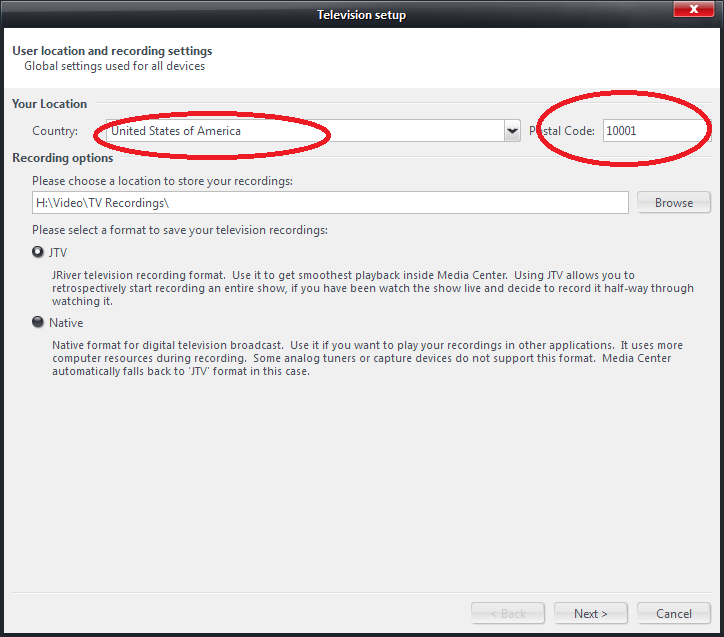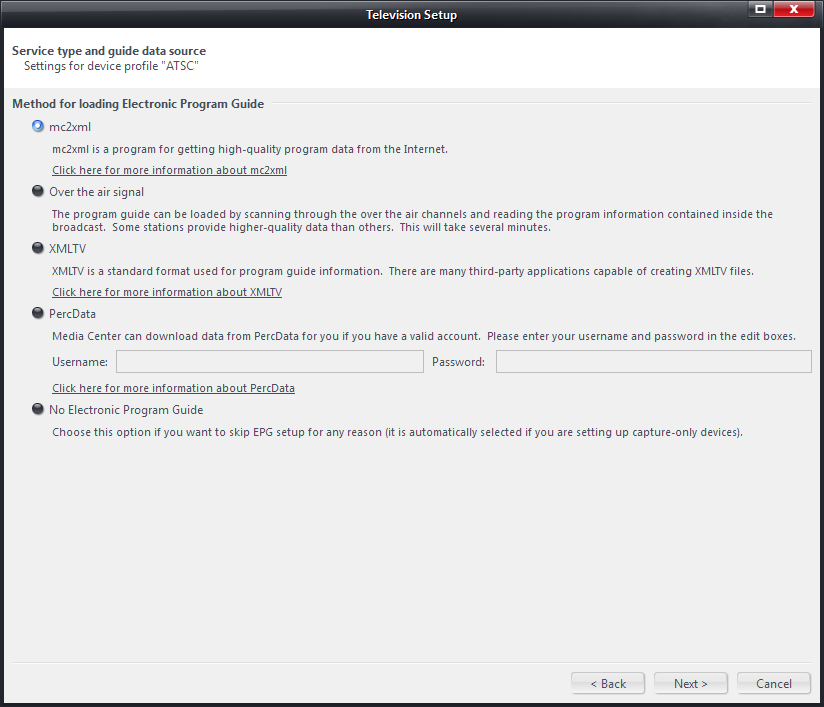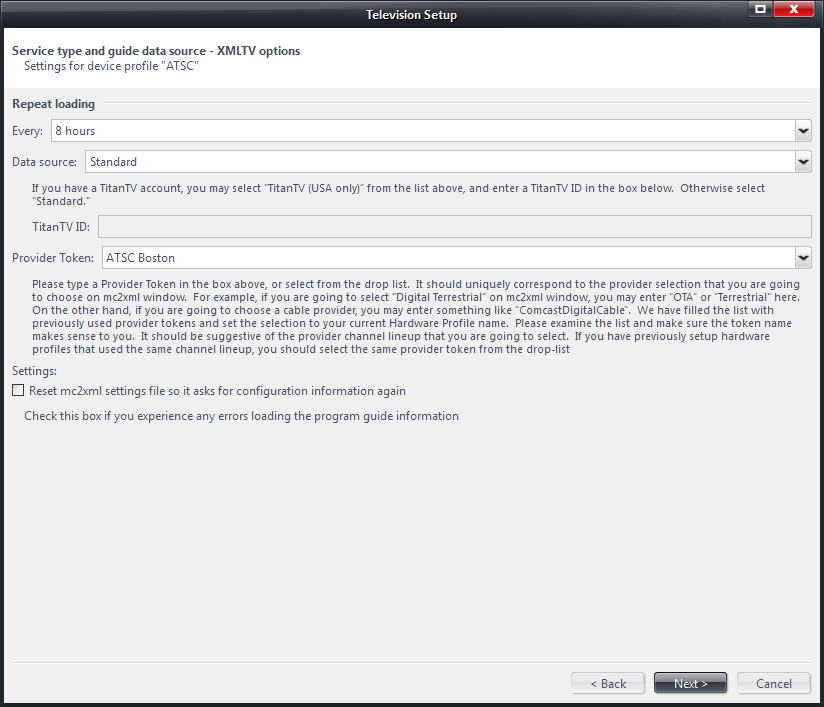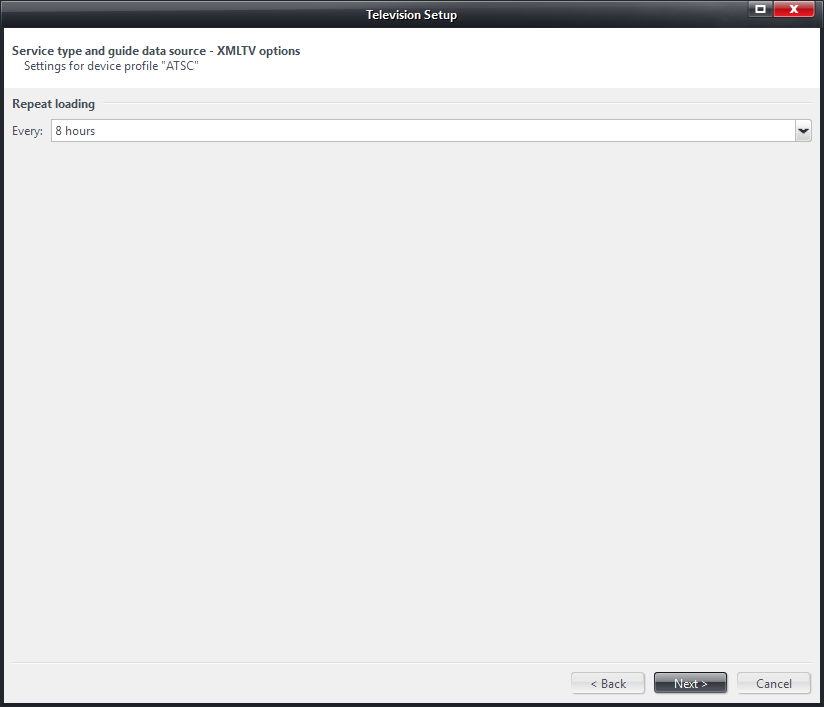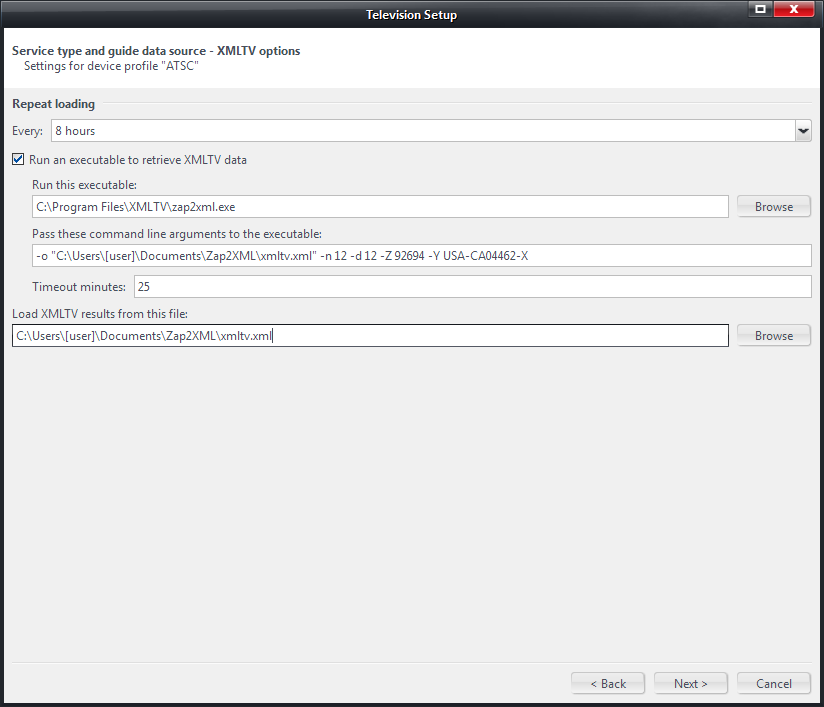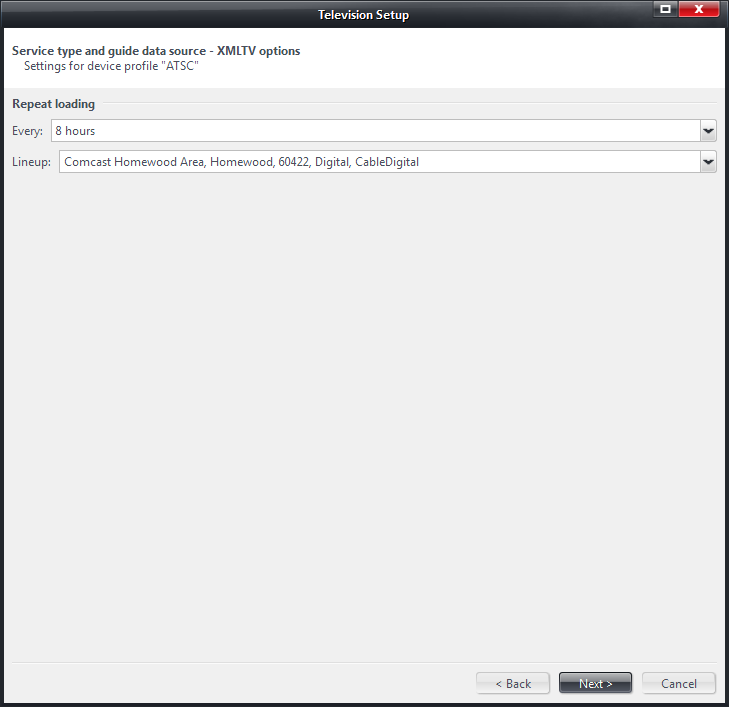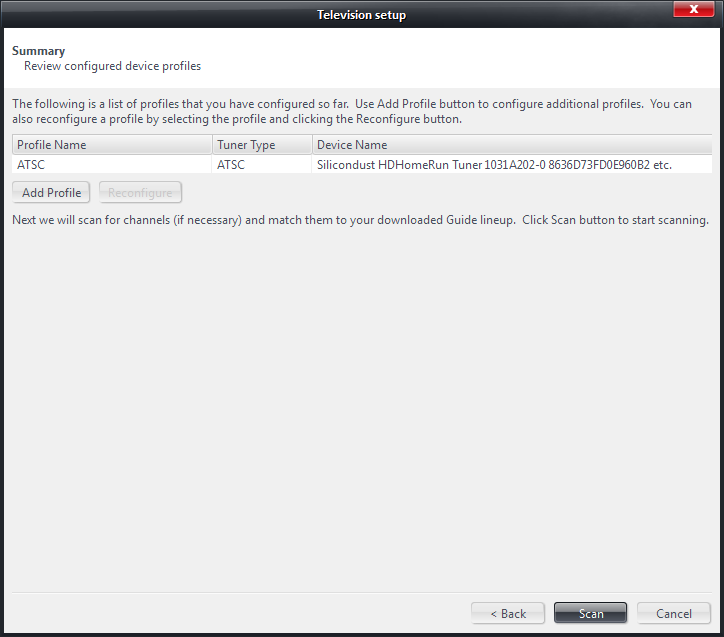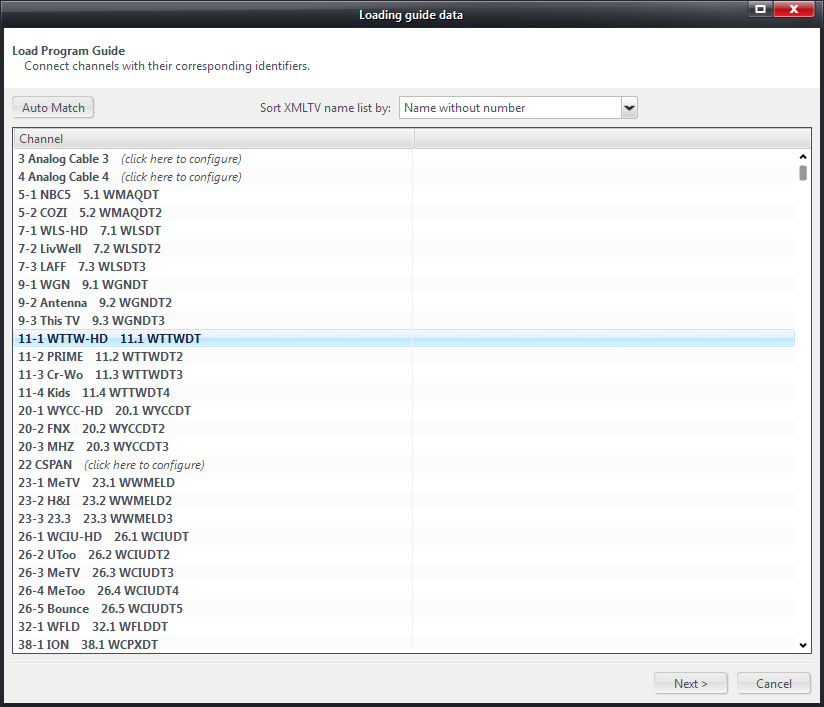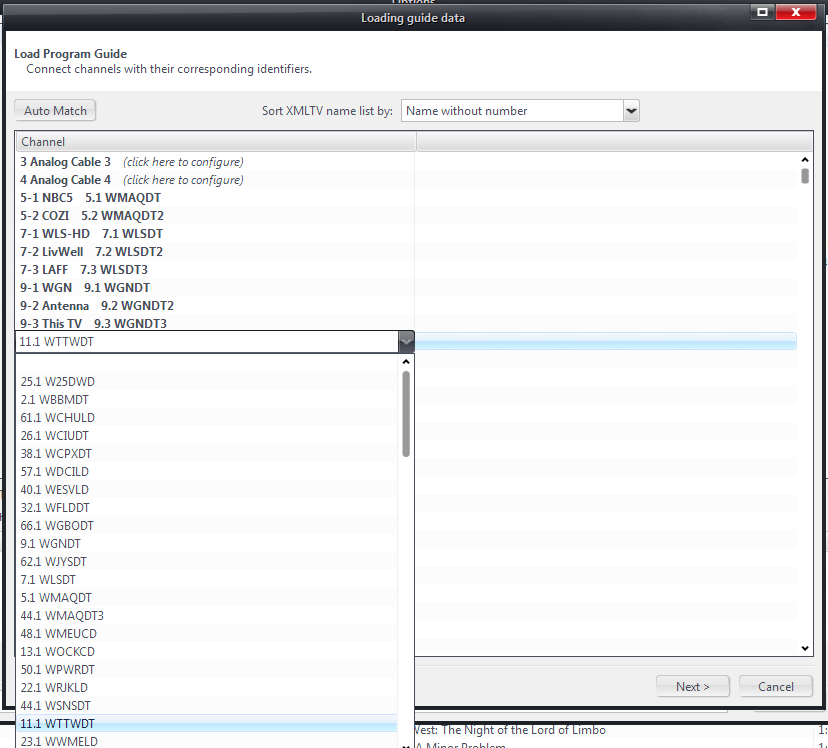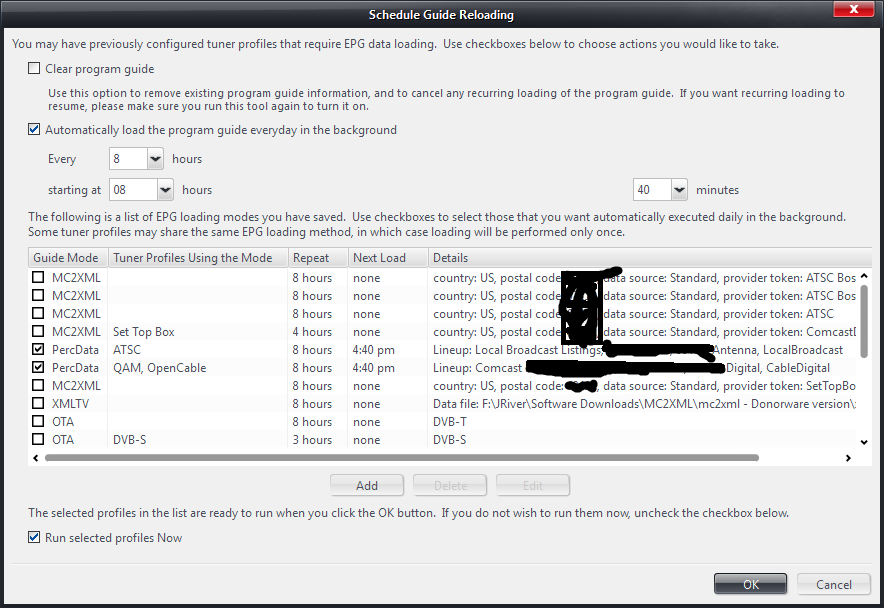EPG: Difference between revisions
(→MC20) |
|||
| (61 intermediate revisions by 2 users not shown) | |||
| Line 1: | Line 1: | ||
An EPG (Electronic Program Guide) provides a schedule of shows for each TV channel. MC can read [http://wiki.jriver.com/index.php/XMLTV XMLTV] data files. |
An EPG (Electronic Program Guide) provides a schedule of shows for each TV channel. MC can read [http://wiki.jriver.com/index.php/XMLTV XMLTV] data files. Since version 17 MC provides a semi-automated way of creating and populating an EPG. Part of it is based on mc2xml. It is no longer necessary to install mc2xml separately. |
||
== |
==MC20 and older== |
||
For those of you with a version prior to MC17, these are the instructions for installing mc2xml: |
|||
The rest of this page applies to MC21 and up. If you use MC20 or older, please read [http://wiki.jriver.com/index.php/EPG_for_MC20_and_Older EPG setup for version 20 and older.] |
|||
You can add an EPG to J. River Media Center. Here are the steps: |
|||
== MC21+ == |
|||
1. [http://mc2xml.my3gb.com/ Download mc2xml] |
|||
Starting with MC20, there is a Setup wizard for setting up TV channels and EPG. The entire wizard is best described in another article [[http://wiki.jriver.com/index.php/Television_Setup Television Setup]]. Here only the steps that involve EPG will be described. Most information on this page apply to versions 21 and up. Some may require version 22 or 23. |
|||
2. Unpack it by running it. Save it anywhere, but remember the location. |
|||
===1. Country and Postal Code=== |
|||
3. In MC, under Drives & Devices > Television, choose Configure/Load Program Guide |
|||
On the first page of the TV Setup wizard, make sure you select your country from the list, and type your postal code correctly. |
|||
4. Follow the on-screen instructions until you see this screen: |
|||
[[image:TV Setup Country and Postal Code.png]] |
|||
[[Image:epg_setup.jpg]] |
|||
5. On that screen, enter the location of the mc2xml.exe file, your country, postal code, and choose "standard" for data source. |
|||
===2. EPG Mode=== |
|||
6. When you choose Next, the mc2xml file will get data from the Internet. After it finishes, you will see this screen: |
|||
A few pages later in the wizard, you will reach this page: |
|||
[[Image:epg_setup2.jpg]] |
|||
[[image:TV Setup EPG mode MC21.png]] |
|||
7. This screen lets you choose an EPG channel for each channel in MC. One, at a time, click in the second column, next to the channel you wish to change. |
|||
Once you've finished this, you should see the schedule for each channel. |
|||
This is where you pick your mode of obtaining EPG data. The number of options available on this page depends on other settings you have chosen so far in the wizard. The picture above shows all available choices. |
|||
==MC17 - MC19== |
|||
For those of you with MC17 through MC19, there is now a semi-automated process. |
|||
*''mc2xml'' |
|||
===Basic Guide Set-up=== |
|||
1. In the left pane in Standard View, select Drives & Devices > Television |
|||
This is now the default option in MC21 and newer. We have integrated mc2xml inside MC since version 21 so it will allow users get EPG data as smoothly as possible. This option is available for users in the USA as well as many other countries. |
|||
2. Select "TV Options" at the bottom left of the main pane. Select "Load Program Guide". |
|||
Additional setup procedure for this option will be discussed in section 3 below. |
|||
[[Image:load_program_guide.jpg]] |
|||
Here is an excellent Interact thread created by CountryBumkin USA TV Setup. He described in this thread, among other things, how to setup mc2xml. While his thread is titled "USA TV Setup", a lot of it is applicable for users in many other countries. |
|||
3. Select the default option - "Download EPG automatically (recommended)" and select your Country, Postal Code and the Provider of the EPG data. The Provider needs to be chosen depending on the type of tuner you are using. The options offered will have been selected based on your location. Now click "Next". |
|||
[https://yabb.jriver.com/interact/index.php?topic=100319.msg695276#msg695276 USA TV Setup] |
|||
[[Image:channel_match.jpg]] |
|||
*''Over the air signal'' |
|||
4. The Load Program Guide channel matching window will pop up. The purpose of this step is to match the channels you have found during the scan to the channel names used in the guide data. Some names will match automatically. If you see "(click here to configure") against a Channel name, a match was not found. This may be because the names differ slightly or there is no guide data available for this channel from the Provider. |
|||
5. Near the top of the window is an Auto Match button. At the time of writing, it is unclear whether it is necessary to click this button. If you do, you will be asked: "If an identifier is already associated with a channel, do you want to keep the existing identifier or use the newly matched identifier?" Imagine you had set up the guide but had a number of channels where no guide data was found. If you run the process again with a different Provider, you might find the data available. In order that you don't change the associations you already have, choose "Keep Existing". If this is the first time you have run the process, choose "Use New". |
|||
In MC22 and newer this option is available for ATSC as well as DVB users. In MC21 it is only for ATSC. It will not be shown if you have not configured any tuner to be ATSC or DVB type. With this option, MC scans EPG data contained in the OTA stream, using an actual tuner. This method was not very reliable but has become much better since MC22. The EPG data contained in the TV signals are not always complete, and you will get spotty results, especially if the TV signal strength/quality is not high. It is therefore recommended that you use other methods of EPG loading unless you have specific reasons to use OTA EPG. By using OTA scan, usually you can get EPG data for the next 12 to 24 hours for ATSC, but up to a week for DVB. If you use this method, it helps if you schedule MC to do more than one loading per day (for example, you can set up MC to load EPG every 8 hours), especially for ATSC. |
|||
6. For each channel where it says "(click to configure)", click on that text and search down the list which pops up and select a channel name which you believe ties up with the scanned channel. |
|||
Please do not confuse the concept of OTA EPG with OTA TV signal itself. Just because you only watch over-the-air TV channels does not mean you have to use the OTA EPG method. You can use mc2xml or XMLTV method for EPG even if you watch OTA TV channels only. |
|||
[[Image:Channel_Match_2.jpg]] |
|||
When you have completed this for each missing match, click "Next". |
|||
*''XMLTV'' |
|||
7. Make sure that the check box next to the "Automatically load" option is checked. This will ensure that your EPG is kept up to date. Click "Finish". |
|||
You will now see the EPG load then the guide data will show in the pane against the channels. |
|||
You can use many third-party applications to download EPG data in XMLTV format. The quality of data varies from application to application. There are two ways of using the data inside MC. See next section for details. |
|||
Now that the EPG is set up, your TV channels will show in Theater View under Video > Guide. |
|||
Here are some Interact threads discussing the subject. |
|||
===Advanced Guide Set-up=== |
|||
[http://yabb.jriver.com/interact/index.php?topic=98447.msg680794#msg680794 Zap2it and Zap2xml] |
|||
The standard guide feature provides only one way of selecting channels using the Favorites marking in the "Edit Channel List" option. A number of users felt some more flexibility was required to have multiple Guide listings with particular types of channels such as Radio and TV or Sports or Kids. In order to achieve this, a new field was added and some work is required by the user. Don't be put off! Taken step by step this is achievable by any user and the results are well worth the effort. |
|||
[http://yabb.jriver.com/interact/index.php?topic=93831.0 Season, Episode number and zap2xml] |
|||
Channels are simply database records, just like audio and video files. This means it's possible to tag them like anything else. The idea is to tag channels with keywords. You can give any channel any number of keywords. Imagine tagging your favorite channels with 'Favorites', music channels with 'Music', and your kids' channels with 'Kids'. |
|||
Additional setup procedure for this option will be discussed in section 3 below. |
|||
Then, you could configure the television guide to show only entries for a particular keyword. So on the top roller inside Guide in Theater View, you could have 'All', 'Favorites', 'Music', 'Kids', etc. |
|||
If you play from one of those views, only the channels in the view will be in the channel up / channel down queue. In other words, if you play from the 'Favorites' list, channel up and channel down will only loop your favorite channels. |
|||
*''PercData'' |
|||
So, to set this up, follow these steps: |
|||
1. Create a Smartlist of the scanned TV Channels. If you haven't done the channel scan yet, go to the instructions in [http://wiki.jriver.com/index.php/Television Television]. If you created the TV Channels Smartlist there, ignore this step. Right click on Playlists in the left pane of Standard View and select "Add Smartlist". Name it, e.g. TV Channels and, under Rules, set Media Type is TV. Remember to uncheck Audio which is the default. Now all your channels will be listed in the main pane. To make sure your smart list is setup correctly, you can check the "Filename" for each entry. They have filename extension "tvlb". The filenames all begin with "TV Channel" and ends with "([tuner type])", like |
|||
PercData is a commercially available EPG data source. In MC21 and up PercData is integrated into MC. MC can download EPG from PercData.com if you have an account with them. You can open an account at PercData, and pay for it, and then enter your user name and password in MC. |
|||
"TV Channel xxxxxxxxxx (ATSC).tvlb" |
|||
"TV Channel xxxxxxxxxx (Set Top Box).tvlb" |
|||
[http://www.percdata.com/ PercData.com] |
|||
2. Right click on the fields title bar and check "Keywords" so that this field will show in the list. |
|||
3. Choose a name for the Guide listing you require. Suppose it is Movies. Scroll down the channel list and decide which channels you want in this Guide. Hold the CTRL key and click on each of these channels to select them. Point to the Keywords field for any of the selected channels and right click and select "Rename". A pop-up containing a field labelled "Add". Type Movies in this field. Hit Return and Movies will appear in the list box below with a check mark. Hit Return again and now Movies should show in all channels selected. |
|||
*''No Electronic Program Guide'' |
|||
4. Repeat step 3 for all other Guide types you want. It is possible to have more than one Keyword for any channel so that channel will appear in each nominated Guide. |
|||
5. We now need to set up Theater View so that these guides are included. In Tools > Options > Theater View > Items to Show, scroll down to Video > Guide and click on Guide. Click "Add" then "Library Item". Name it 'Movies' or whatever you want your new guide to be called. |
|||
This option is provided so that you can skip EPG setup. While skipping EPG setup is generally not recommended, there are situations in which this makes sense. This is particularly true if you are setting up "Capture-only" channels. For example you can setup a video capture device to capture video from your camcorder. In this case EPG simply is irrelevant. |
|||
6. Click 'Set rules for file display...' and click "Import/Export". Copy and paste this rule into the box - (thanks Matt): |
|||
===3. Additional setup details=== |
|||
[TVTime]=#TVGuideStartDate-7d [=TVInfo(ChannelKeywords)&DataType=[list]]=[Movies] |
|||
Click "OK". Two custom rules will have been set up. Click "Apply" then "OK". |
|||
For each of the four cases discussed below, you are able to set a "Repeat Loading" parameter. This feature is added in version 23 and is not available for MC21 and MC22. It represents the time between automatic background loads for each EPG loading mode. Under "Repeat Loading" you can select a value from the dropdown list. It ranges from 15 minutes to 24 hours. For most people, 24 hours is a good choice. 15 minutes is not recommended unless you know that your TV stations (for example DVB-T) change program information frequently, and the scan takes less than 15 minutes to complete. Most online data sources update their information two or three times a day. |
|||
In the rule above, replace Movies with the Keyword you have used to identify the channels you want included in this Guide. |
|||
Note: for MC22 and earlier, "Repeat loading" interval is a global parameter set elsewhere. You can not choose a different value for different epg loading modes. |
|||
8. In Theater View, navigate to your new view. Use More > Toggle List Style to find the style you prefer (grid, list, etc.). |
|||
3a. Additional setup details for mc2xml |
|||
Now you have your own set of personalised EPGs. |
|||
If you choose "mc2xml" option in step 2, you will get the following screen upon clicking the Next button: |
|||
Remember that only channels which have a XMLTV ID associated with them will show up in your guides. |
|||
[[image:TV setup mc2xml options MC23.png]] |
|||
===Including a Clock on the Guide Page=== |
|||
It is useful to have a clock displayed when making decisions related to the Guide. Unfortunately, the current Guide page does not show a clock. This can be resolved by making a change to the Theater View Skin definition. If you have already customised your skin, the change is simple. If not, you will need to create your own Skin folder. |
|||
"Repeat Loading" (MC23 and up only) - select a time interval between repeated background EPG loading. |
|||
1. Check which Theater View skin you are using - go to Tools > Options > Theater View > Appearance > Skin. Remember the name. |
|||
"Data Source" - For most people, Standard should be used. If you use TitanTV, you may try using that option. If you do choose TitanTV, you need to enter the TitanTV ID in the next field. |
|||
2. In Windows Explorer, find Program Files\J River\Media Center 17\Skins\Theater View. You should see a folder with the name of your current skin. Copy and paste this folder into the Theater View folder and rename it with a name of your choice. |
|||
"Provider Token" - This is a unique text string that you should enter, so that you can differentiate between different instances of mc2xml runs with different parameters. The explanation text below the dropdown list should give you a clear idea what this field is used for. |
|||
3. Open the folder and find the main.xml file. If you are familiar with editing XML files, you may wish to use an XML editor, otherwise open it with Notebook. Near the top of the file, you will see an entry beginning with <SKIN Name=. Change the name in quotes to the name you chose for your skin. |
|||
"Reset mc2xml settings file so it asks for configuration information again" - this checkbox is deprecate and will be removed in the future. It is simply not needed. |
|||
4. Near the bottom of the file you may find an entry beginning with <TEXT>. If so, insert this line just above the </TEXT> label (Thanks Sean): |
|||
<Item Text="[Time]" Location="***" TextColor="ffffff" Rect="72,00,96,05" Capitalization="0" Alignment="1" Alpha="50" Size="[Large Text Height]" /> |
|||
5. If there is no existing <TEXT> entry, insert the following 3 lines immediately beforethe line containing </MJFS> |
|||
<TEXT> |
|||
<Item Text="[Time]" Location="***" TextColor="ffffff" Rect="72,00,96,05" Capitalization="0" Alignment="1" Alpha="50" Size="[Large Text Height]" /> |
|||
</TEXT> |
|||
3b. Additional setup details for OTA EPG |
|||
6. In Theater View Guide, you should now see a clock in the top right corner. |
|||
If you choose "Over-the-air signal" option in step 2, you get the following page upon clicking the Next button: |
|||
== MC20 == |
|||
Starting with MC20, there is a Setup wizard for setting up TV channels and EPG. The entire wizard is best described in another article. Here only the steps that involve EPG will be described. |
|||
[[image:TV setup OTA options MC23.png]] |
|||
1. Country and Postal code. On the first page of the TV Setup wizard, make sure you select your country from the list, and type your postal code correctly. |
|||
[[image:TV Setup Country and Postal Code.png]] |
|||
This page shows up only for MC23 since it contains only the "Repeat Loading" dropdown list which is new in MC23. |
|||
2. A few pages later in the wizard, you will reach this page: |
|||
3c. Additional setup details for XMLTV |
|||
[[image:TV Setup EPG mode.png]] |
|||
If you choose "XMLTV" option in step 2, you get the following page upon clicking the Next button: |
|||
This is where you pick your mode of obtaining EPG data. The number of options available on this page depends on other settings you have chosen so far in the wizard. The picture above shows all available choices. |
|||
[[image:TV Setup XMLTV Options MC23.png]] |
|||
*''2.1 Download EPG Automatically (recommended)'' |
|||
This option is not available in all countries. Where it is not available, it is not shown on the wizard page. If you do not see this option, but believe it should be available, you should first make sure that the country and postal code data are entered correctly, as described in step 1 above. If you still do not get the option, it maybe due to bad network condition that prevents data from being downloaded properly. You can quit the wizard and try again at a later time. Countries and regions in which this option is known to be available include, United States, Canada, Japan, India, Taiwan, etc. |
|||
"Repeat Loading" (MC23 and up only) - select a time interval between repeated background EPG loading. |
|||
When this option is available, you are presented with a list of "providers". Basically this is a list of cable TV and satellite TV providers. Selecting a provider will allow MC to download EPG data for all channels that the selected provider offer in their lineup. For people who do not subscribe to cable or satellite TV, but only use over-the-air services, an important entry in the "Providers" list is "Digital Terrestrial Lineup". Choosing this one allows MC to download EPG data only for your local OTA channels. This is not available in all locations. For example, it is not available in some Canadian cities. If you do not find "Digital Terrestrial Lineup" from the listed providers, try looking for something with a different name, but has similar meaning, such as "Over the Air Lineup". If this also fails, then you can simply choose a cable provider (even though you are not a subscriber to cable!), because most cable providers do offer OTA channels in their lineup (at least in the USA anyway). Choosing a cable provider when you only need data for OTA channels has a down side. MC would have to download large amount of data that correspond to cable channels. But at least you will be able to get data for your OTA channels. |
|||
*''2.2 Over the air signal (ATSC only)'' |
|||
There are two ways to execute a third-party XMLTV program: inside MC or outside of MC. |
|||
This option is currently only available for ATSC users. It will not be shown if you have not configured any tuner to be ATSC type. With this option, MC scans EPG data contained in the OTA stream, using an actual tuner. This method is not very reliable. MC sometimes would not pick up any data for a given channel, or for a certain time period. It is therefore recommended that you use other mode of obtaining EPG data, unless it is absolutely necessary to use this method. If you use this method, it helps if you schedule MC to do more than one loading per day (for example, you can set up MC to load EPG every 6 hours). |
|||
To run the program inside MC, check the checkbox "Run an executable to retrieve XMLTV data", and fill in all boxes below it. Under "Run this executable:", choose the executable file of the third-party program that you have installed. Under "Pass these command line arguments to the executable:" enter parameters for the program. You should also fill in the box under "Load XMLTV results from this file:", to tell MC which data file to load info from. Zap2xml is used as an example in the screenshot above. |
|||
*''2.3 XMLTV'' |
|||
If you uncheck the checkbox "Run an executable to retrieve XMLTV data", MC will not run the third-party program on your behalf. Instead, you can schedule for it to be executed using Windows Scheduler. Then schedule MC to load the output file produced by it, using the box under "Load XMLTV results from this file:". |
|||
You can use many third-party applications to download EPG data in XMLTV format. The quality of data varies from application to application. There are two ways of using the data inside MC. See next section for details. |
|||
See the following Interact thread for discussion on command line parameters used by zap2xml, and how to schedule it in Windows scheduler: |
|||
Here are some Interact threads discussion the subject. |
|||
[http://yabb.jriver.com/interact/index.php?topic= |
[http://yabb.jriver.com/interact/index.php?topic=93831.0 Season, Episode number and zap2xml] |
||
[http://yabb.jriver.com/interact/index.php?topic=93831.0 Season, Episode number and zap2it] |
|||
3d. Additional setup details for PercData |
|||
Additional set up procedure for this option will be discussed in section 3 below. |
|||
If you choose "PercData" in step 2, you get the following page upon clicking the Next button: |
|||
*''2.4 mc2xml'' |
|||
mc2xml is a program that downloads EPG data from the Internet. If you choose this option, MC will run this third-party application and load EPG data that it downloads. |
|||
[[image: TV Setup PercData Options.png]] |
|||
Additional info on setting up this option is in the next section. |
|||
3a. Additional setup details for XMLTV |
|||
There are two dropdown lists on this page: |
|||
If you choose "XMLTV" option in step 2, you will get the following screen upon clicking the Next button: |
|||
"Repeat Loading" (MC23 and up only) - select a time interval between repeated background EPG loading. |
|||
"Lineup" - When you subscribe to PercData, you are allowed to set up 4 lineups for your area. For example, you may choose "Comcast Digital", "AT&T UVerse", "DirecTV", and "Local Broadcast" among a number of available lineups. MC can load data for any one of these lineups. |
|||
[[image:TV Setup XMLTV Options.png]] |
|||
===4. Multiple guide sources.=== |
|||
You can setup using multiple guide sources. It is useful if you have multiple types of tuners that require you to set up multiple types of channels. |
|||
There are two ways to execute a third-party XMLTV program: inside MC or outside of MC. |
|||
When you click Next on the Setup wizard, you will arrive at a summary page as shown below. |
|||
To run the program inside MC, check the checkbox "Run an executable to retrieve XMLTV data", and fill in the two boxes below it. Under "Run this executable:", choose the executable file of the third-party program that you have installed. Under "Pass these command line arguments to the executable:" enter parameters for the program. Zap2xml is used as an example. |
|||
[[image:TV setup Summary of profiles.png]] |
|||
If you uncheck the checkbox "Run an executable to retrieve XMLTV data", MC will not run the third-party program on your behalf. Instead, you can schedule for it to be executed using Windows Scheduler. Then schedule MC to load the output file produced by it, using the box under "Load XMLTV results from this file:". |
|||
The screenshot shows one device profile ("ATSC") already setup in the process. You can add more device profiles (also called "tuner type profiles") by clicking the "Add Profile" button. Each profile is associated with one tuner type. |
|||
See the following Interact thread for discussion on command line parameters used by zap2it, and how to schedule it in Windows scheduler: |
|||
Each profile may be associated with up to one (i.e. one or none) EPG loading mode. For example, you may use "mc2xml" mode with a provider choice that corresponds to your cable company channel lineup (e.g. "Minneapolis, Comcast (digital)") for your CableCARD channels, and use "mc2xml" mode with provider choice "Digital terrestrial lineup" for your ATSC OTA channels. |
|||
[http://yabb.jriver.com/interact/index.php?topic=93831.0 Season, Episode number and zap2it] |
|||
Please note, however, that it is not beneficial to associate identical EPG mode with different channel types. In Theater View's Guide grid, each program entry is associated with one channel. If an program entry is associated with more than one channel, the second channel will not appear in the grid. The EPG modes given as examples above are not considered identical because the provider choices are different. If you have multiple types of channels that need to use the same EPG source (with identical channel lineup, such as your STB channels for your cable lineup, and your CableCARD channels from the same cable company). the correct way is to group the two types of channels. Even if your two channel types do not have identical lineup, it is still advisable to group the overlapping channels. For example, you should group your ATSC OTA channels with the corresponding cable channels. This way you will not even need to obtain EPG data from two sources. |
|||
===5. Final step=== |
|||
3b. Additional setup details for mc2xml |
|||
When you click "Scan" button on the summary page shown above, MC starts to scan for channels, running all profiles you set up one by one. After that, MC starts to load EPG, according to your profile setup. MC will run non-OTA EPG modes first, and OTA EPG mode last. When you run non-OTA loading modes, a XMLTV ID-to-channel mapping page will appear. Examine the page and make sure the channels are associated with XMLTV IDs. This mapping allows each downloaded EPG program entry to be associated with the correct channel. |
|||
If you choose "mc2xml" option in step 2, you will get the following screen upon clicking the Next button: |
|||
Here is the screenshot of XMLTV ID-to-channel mapping window: |
|||
[[image:TV setup mc2xml options.png]] |
|||
[[image:Load program guide XMLTV ID matching MC23.png]] |
|||
This is similar to what is described under "Pre MC17", except that Country and postal code are already collected, as described in step 1, and that you do not need to specify the location of the mc2xml executable. |
|||
Depending on the type of channels you have, most channels should automatically be matched with corresponding xmltv IDs. It may be necessary to manually make some maps (see "Note 1" below however). |
|||
Near the top of the window is an "Auto Match" button. If you find a lot of unmatched channels, you may try clicking the button and let MC go through its auto-match routine. If you do, you will be asked: "If an identifier is already associated with a channel, do you want to keep the existing identifier or use the newly matched identifier?" Imagine you had set up the guide but had a number of channels where no guide data was found. If you run the process again with a different Provider, you might find the data available. In order that you don't change the associations you already have, choose "Keep Existing". If this is the first time you have run the process, choose "Use New". |
|||
4. Multiple guide sources. |
|||
An unmatched channel will appear with the text "(click to configure)". You can attempt to make a match manually by click on that text and search down the list which pops up and select a channel name which you believe ties up with the scanned channel. On the screenshot below you see that the name "11.1 WTTWDT" is selected to match the channel "11-1 WTTW-HD". |
|||
You can setup using multiple guide sources. It is useful if you have multiple types of tuners that require you to set up multiple types of channels. |
|||
When you click Next on the Setup wizard, you will arrive at a summary page as shown below. |
|||
[[image: |
[[image:Load program guide XMLTV ID matching dropdown MC23.png]] |
||
To help you find the correct match visually, there are two ways of sorting the list in the dropdown - sort by name without the channel number, or sort by name with the channel number. This can be changed by selecting the desired method from the "Sort XMLTV name list by:" drop list right above the main channel list (to the right of the "Auto Match" button"). The screenshot above shows that the xmltv names are sorted by name without the channel numbers that appear before the names. |
|||
<to be continued> |
|||
Note 1: if you set up multiple types of channels with multiple EPG loading modes, do not be alarmed when you find some of your channels not associated with an XMLTV ID. For example, suppose you have cable subscription and you also use ATSC OTA channels, and you use two EPG modes used as examples above (with providers "Minneapolis, Comcast (digital)" and "Digital terrestrial lineup"), then the XMLTV ID-to-Channel mapping page will appear twice. If your cable channel 5 is your local NBC channel, and the corresponding ATSC channel is channel 5-1, then the first time the page appears, channel 5-1 may not be associated with any ID, because the association is for the cable channels. When the page appears the second time, it will be for ATSC channels, and all your cable channels will not have any association shown. |
|||
Note 2: There is no XMLTV ID-To-Channel mapping page showing for OTA EPG scanning. OTA EPG scanning will be done after all other EPG methods are complete, and will happen in the background. |
|||
===6. After initial setup=== |
|||
When Setup wizard finish, EPG should have been set up for you correctly. You should be able to see programming entries in either Theater View or Standard View. MC automatically schedule all your EPG loading in the background using your specified repeat time interval. |
|||
You can modify the scheduling by going to TV Options > General > Load Program Guide... The following window appears: |
|||
[[image:Load program guide MC23.png]] |
|||
From top to bottom: |
|||
*''Clear Program Guide'' |
|||
This should be self explanatory. The instruction on the window is sufficiently clear. |
|||
*''Automatically load program guide every day in the background'' |
|||
This is checked by default. You can select the frequency of EPG loading (6, 8, 12, or 24 hours for example). You can also set at what time (hour and minute) MC should try. MC will try loading EPG immediately after the set time, or as soon as possible thereafter. The top entry in the "Hour" drop list is "Default", which means "24 hours (or whatever number of hours you choose) after it was run the last time". |
|||
Note that the repeat time interval selected here is the global default value. It is used only if an EPG loading mode does not have the repeat interval specified (for EPG loading modes created prior to MC23). |
|||
*''List of EPG loading modes'' |
|||
The list contains all EPG loading modes that you have setup. Those with the checkbox checked are the ones that will be run automatically. You may choose to delete those that you no longer need, by selecting them, and clicking the "Delete" button. You may also add new EPG mode by clicking "Add" button. EPG modes added this way are not actually associated with any particular tuner type profile. That does not really matter. There is also an Edit button. Clicking it after selecting a particular EPG loading mode brings up the options window appropriate to the selected mode, almost identical to those discussed in the section "3. Additional setup details." |
|||
Note that columns 3 and 4 of the list in the screenshot ("Repeat" and "Next Load") are not present in MC22 and older since per-mode repeat interval specification is an MC23 feature. |
|||
*''Run selected profiles now'' |
|||
If this checkbox is checked (it is checked by default), the selected EPG loading methods will be executed after you click "OK" button. Unckeck the checkbox if you do not want it to happen. |
|||
==EPG for Australia== |
==EPG for Australia== |
||
There are useful discussions on |
There are useful discussions on Interact to set up an EPG in an Australian context. To use epgstream.net look [http://yabb.jriver.com/interact/index.php?topic=72202.msg488798#msg488798 here] on Interact. To use EPG Collector and some other options, look [http://yabb.jriver.com/interact/index.php?topic=67992.0 here] and [http://yabb.jriver.com/interact/index.php?topic=72715.0 here]. |
||
==EPG for the UK== |
|||
For EPG set up in the UK using EPG Collector, there are useful discussions on this [http://yabb.jriver.com/interact/index.php?topic=77177.0 here] on Interact. |
|||
==More== |
==More== |
||
| Line 210: | Line 227: | ||
* [[Television]] |
* [[Television]] |
||
* [[TV Shows - Series, Seasons & Episodes]] |
* [[TV Shows - Series, Seasons & Episodes]] |
||
* [[Television Setup]] |
|||
[https://wiki.jriver.com/index.php/EPG#MC20_and_older Back to top] |
|||
[[Category: Frequently Asked Questions]] |
[[Category: Frequently Asked Questions]] |
||
[[Category:Television]] |
[[Category:Television]] |
||
Latest revision as of 13:45, 14 June 2018
An EPG (Electronic Program Guide) provides a schedule of shows for each TV channel. MC can read XMLTV data files. Since version 17 MC provides a semi-automated way of creating and populating an EPG. Part of it is based on mc2xml. It is no longer necessary to install mc2xml separately.
MC20 and older
The rest of this page applies to MC21 and up. If you use MC20 or older, please read EPG setup for version 20 and older.
MC21+
Starting with MC20, there is a Setup wizard for setting up TV channels and EPG. The entire wizard is best described in another article [Television Setup]. Here only the steps that involve EPG will be described. Most information on this page apply to versions 21 and up. Some may require version 22 or 23.
1. Country and Postal Code
On the first page of the TV Setup wizard, make sure you select your country from the list, and type your postal code correctly.
2. EPG Mode
A few pages later in the wizard, you will reach this page:
This is where you pick your mode of obtaining EPG data. The number of options available on this page depends on other settings you have chosen so far in the wizard. The picture above shows all available choices.
- mc2xml
This is now the default option in MC21 and newer. We have integrated mc2xml inside MC since version 21 so it will allow users get EPG data as smoothly as possible. This option is available for users in the USA as well as many other countries.
Additional setup procedure for this option will be discussed in section 3 below.
Here is an excellent Interact thread created by CountryBumkin USA TV Setup. He described in this thread, among other things, how to setup mc2xml. While his thread is titled "USA TV Setup", a lot of it is applicable for users in many other countries.
- Over the air signal
In MC22 and newer this option is available for ATSC as well as DVB users. In MC21 it is only for ATSC. It will not be shown if you have not configured any tuner to be ATSC or DVB type. With this option, MC scans EPG data contained in the OTA stream, using an actual tuner. This method was not very reliable but has become much better since MC22. The EPG data contained in the TV signals are not always complete, and you will get spotty results, especially if the TV signal strength/quality is not high. It is therefore recommended that you use other methods of EPG loading unless you have specific reasons to use OTA EPG. By using OTA scan, usually you can get EPG data for the next 12 to 24 hours for ATSC, but up to a week for DVB. If you use this method, it helps if you schedule MC to do more than one loading per day (for example, you can set up MC to load EPG every 8 hours), especially for ATSC.
Please do not confuse the concept of OTA EPG with OTA TV signal itself. Just because you only watch over-the-air TV channels does not mean you have to use the OTA EPG method. You can use mc2xml or XMLTV method for EPG even if you watch OTA TV channels only.
- XMLTV
You can use many third-party applications to download EPG data in XMLTV format. The quality of data varies from application to application. There are two ways of using the data inside MC. See next section for details.
Here are some Interact threads discussing the subject.
Season, Episode number and zap2xml
Additional setup procedure for this option will be discussed in section 3 below.
- PercData
PercData is a commercially available EPG data source. In MC21 and up PercData is integrated into MC. MC can download EPG from PercData.com if you have an account with them. You can open an account at PercData, and pay for it, and then enter your user name and password in MC.
- No Electronic Program Guide
This option is provided so that you can skip EPG setup. While skipping EPG setup is generally not recommended, there are situations in which this makes sense. This is particularly true if you are setting up "Capture-only" channels. For example you can setup a video capture device to capture video from your camcorder. In this case EPG simply is irrelevant.
3. Additional setup details
For each of the four cases discussed below, you are able to set a "Repeat Loading" parameter. This feature is added in version 23 and is not available for MC21 and MC22. It represents the time between automatic background loads for each EPG loading mode. Under "Repeat Loading" you can select a value from the dropdown list. It ranges from 15 minutes to 24 hours. For most people, 24 hours is a good choice. 15 minutes is not recommended unless you know that your TV stations (for example DVB-T) change program information frequently, and the scan takes less than 15 minutes to complete. Most online data sources update their information two or three times a day.
Note: for MC22 and earlier, "Repeat loading" interval is a global parameter set elsewhere. You can not choose a different value for different epg loading modes.
3a. Additional setup details for mc2xml
If you choose "mc2xml" option in step 2, you will get the following screen upon clicking the Next button:
"Repeat Loading" (MC23 and up only) - select a time interval between repeated background EPG loading.
"Data Source" - For most people, Standard should be used. If you use TitanTV, you may try using that option. If you do choose TitanTV, you need to enter the TitanTV ID in the next field.
"Provider Token" - This is a unique text string that you should enter, so that you can differentiate between different instances of mc2xml runs with different parameters. The explanation text below the dropdown list should give you a clear idea what this field is used for.
"Reset mc2xml settings file so it asks for configuration information again" - this checkbox is deprecate and will be removed in the future. It is simply not needed.
3b. Additional setup details for OTA EPG
If you choose "Over-the-air signal" option in step 2, you get the following page upon clicking the Next button:
This page shows up only for MC23 since it contains only the "Repeat Loading" dropdown list which is new in MC23.
3c. Additional setup details for XMLTV
If you choose "XMLTV" option in step 2, you get the following page upon clicking the Next button:
"Repeat Loading" (MC23 and up only) - select a time interval between repeated background EPG loading.
There are two ways to execute a third-party XMLTV program: inside MC or outside of MC.
To run the program inside MC, check the checkbox "Run an executable to retrieve XMLTV data", and fill in all boxes below it. Under "Run this executable:", choose the executable file of the third-party program that you have installed. Under "Pass these command line arguments to the executable:" enter parameters for the program. You should also fill in the box under "Load XMLTV results from this file:", to tell MC which data file to load info from. Zap2xml is used as an example in the screenshot above.
If you uncheck the checkbox "Run an executable to retrieve XMLTV data", MC will not run the third-party program on your behalf. Instead, you can schedule for it to be executed using Windows Scheduler. Then schedule MC to load the output file produced by it, using the box under "Load XMLTV results from this file:".
See the following Interact thread for discussion on command line parameters used by zap2xml, and how to schedule it in Windows scheduler:
Season, Episode number and zap2xml
3d. Additional setup details for PercData
If you choose "PercData" in step 2, you get the following page upon clicking the Next button:
There are two dropdown lists on this page:
"Repeat Loading" (MC23 and up only) - select a time interval between repeated background EPG loading.
"Lineup" - When you subscribe to PercData, you are allowed to set up 4 lineups for your area. For example, you may choose "Comcast Digital", "AT&T UVerse", "DirecTV", and "Local Broadcast" among a number of available lineups. MC can load data for any one of these lineups.
4. Multiple guide sources.
You can setup using multiple guide sources. It is useful if you have multiple types of tuners that require you to set up multiple types of channels.
When you click Next on the Setup wizard, you will arrive at a summary page as shown below.
The screenshot shows one device profile ("ATSC") already setup in the process. You can add more device profiles (also called "tuner type profiles") by clicking the "Add Profile" button. Each profile is associated with one tuner type.
Each profile may be associated with up to one (i.e. one or none) EPG loading mode. For example, you may use "mc2xml" mode with a provider choice that corresponds to your cable company channel lineup (e.g. "Minneapolis, Comcast (digital)") for your CableCARD channels, and use "mc2xml" mode with provider choice "Digital terrestrial lineup" for your ATSC OTA channels.
Please note, however, that it is not beneficial to associate identical EPG mode with different channel types. In Theater View's Guide grid, each program entry is associated with one channel. If an program entry is associated with more than one channel, the second channel will not appear in the grid. The EPG modes given as examples above are not considered identical because the provider choices are different. If you have multiple types of channels that need to use the same EPG source (with identical channel lineup, such as your STB channels for your cable lineup, and your CableCARD channels from the same cable company). the correct way is to group the two types of channels. Even if your two channel types do not have identical lineup, it is still advisable to group the overlapping channels. For example, you should group your ATSC OTA channels with the corresponding cable channels. This way you will not even need to obtain EPG data from two sources.
5. Final step
When you click "Scan" button on the summary page shown above, MC starts to scan for channels, running all profiles you set up one by one. After that, MC starts to load EPG, according to your profile setup. MC will run non-OTA EPG modes first, and OTA EPG mode last. When you run non-OTA loading modes, a XMLTV ID-to-channel mapping page will appear. Examine the page and make sure the channels are associated with XMLTV IDs. This mapping allows each downloaded EPG program entry to be associated with the correct channel.
Here is the screenshot of XMLTV ID-to-channel mapping window:
Depending on the type of channels you have, most channels should automatically be matched with corresponding xmltv IDs. It may be necessary to manually make some maps (see "Note 1" below however).
Near the top of the window is an "Auto Match" button. If you find a lot of unmatched channels, you may try clicking the button and let MC go through its auto-match routine. If you do, you will be asked: "If an identifier is already associated with a channel, do you want to keep the existing identifier or use the newly matched identifier?" Imagine you had set up the guide but had a number of channels where no guide data was found. If you run the process again with a different Provider, you might find the data available. In order that you don't change the associations you already have, choose "Keep Existing". If this is the first time you have run the process, choose "Use New".
An unmatched channel will appear with the text "(click to configure)". You can attempt to make a match manually by click on that text and search down the list which pops up and select a channel name which you believe ties up with the scanned channel. On the screenshot below you see that the name "11.1 WTTWDT" is selected to match the channel "11-1 WTTW-HD".
To help you find the correct match visually, there are two ways of sorting the list in the dropdown - sort by name without the channel number, or sort by name with the channel number. This can be changed by selecting the desired method from the "Sort XMLTV name list by:" drop list right above the main channel list (to the right of the "Auto Match" button"). The screenshot above shows that the xmltv names are sorted by name without the channel numbers that appear before the names.
Note 1: if you set up multiple types of channels with multiple EPG loading modes, do not be alarmed when you find some of your channels not associated with an XMLTV ID. For example, suppose you have cable subscription and you also use ATSC OTA channels, and you use two EPG modes used as examples above (with providers "Minneapolis, Comcast (digital)" and "Digital terrestrial lineup"), then the XMLTV ID-to-Channel mapping page will appear twice. If your cable channel 5 is your local NBC channel, and the corresponding ATSC channel is channel 5-1, then the first time the page appears, channel 5-1 may not be associated with any ID, because the association is for the cable channels. When the page appears the second time, it will be for ATSC channels, and all your cable channels will not have any association shown.
Note 2: There is no XMLTV ID-To-Channel mapping page showing for OTA EPG scanning. OTA EPG scanning will be done after all other EPG methods are complete, and will happen in the background.
6. After initial setup
When Setup wizard finish, EPG should have been set up for you correctly. You should be able to see programming entries in either Theater View or Standard View. MC automatically schedule all your EPG loading in the background using your specified repeat time interval.
You can modify the scheduling by going to TV Options > General > Load Program Guide... The following window appears:
From top to bottom:
- Clear Program Guide
This should be self explanatory. The instruction on the window is sufficiently clear.
- Automatically load program guide every day in the background
This is checked by default. You can select the frequency of EPG loading (6, 8, 12, or 24 hours for example). You can also set at what time (hour and minute) MC should try. MC will try loading EPG immediately after the set time, or as soon as possible thereafter. The top entry in the "Hour" drop list is "Default", which means "24 hours (or whatever number of hours you choose) after it was run the last time".
Note that the repeat time interval selected here is the global default value. It is used only if an EPG loading mode does not have the repeat interval specified (for EPG loading modes created prior to MC23).
- List of EPG loading modes
The list contains all EPG loading modes that you have setup. Those with the checkbox checked are the ones that will be run automatically. You may choose to delete those that you no longer need, by selecting them, and clicking the "Delete" button. You may also add new EPG mode by clicking "Add" button. EPG modes added this way are not actually associated with any particular tuner type profile. That does not really matter. There is also an Edit button. Clicking it after selecting a particular EPG loading mode brings up the options window appropriate to the selected mode, almost identical to those discussed in the section "3. Additional setup details."
Note that columns 3 and 4 of the list in the screenshot ("Repeat" and "Next Load") are not present in MC22 and older since per-mode repeat interval specification is an MC23 feature.
- Run selected profiles now
If this checkbox is checked (it is checked by default), the selected EPG loading methods will be executed after you click "OK" button. Unckeck the checkbox if you do not want it to happen.
EPG for Australia
There are useful discussions on Interact to set up an EPG in an Australian context. To use epgstream.net look here on Interact. To use EPG Collector and some other options, look here and here.
EPG for the UK
For EPG set up in the UK using EPG Collector, there are useful discussions on this here on Interact.
